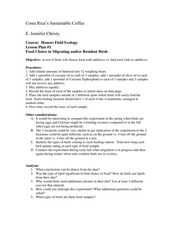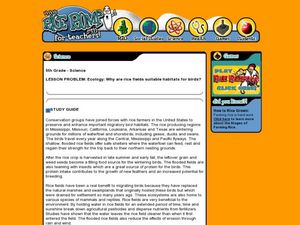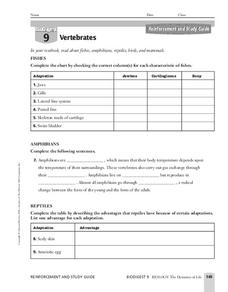Curated OER
Bird Airport Control
Students visit a local wetland and record observations of waterfowl on downloadable worksheets. They compile class data and list similarities and differences among species of birds observed.
Curated OER
Competition as a Function of Interactions in the Environment
Students set up various feeding stations and observe bird behavior and gather data.
Curated OER
Fill The Bill
Students identify and describe five different types of beaks. Using that information, they explain how each of them is adapted to feed on different foods. In groups, they travel around the room to various stations in order to practice...
Curated OER
Flocking to Food
Students observe shore birds feeding. In this shore birds lesson, students visit a beach and observe shore birds feeding. Students discuss shore birds feeding behaviors.
Curated OER
Bird Beaks and Feet
In this bird adaptations worksheet, students look at different bird pictures and determine what the bird eats and where it lives by looking at its beak and feet. Students complete a graphic organizer and 5 short answer questions.
Curated OER
For The Birds Challenge
In this bird worksheet, learners complete a set of 10 multiple choice questions about features of birds. A reference web site is given, but no information about birds is contained in worksheet.
Curated OER
Why Do Birds Sing
In this reading comprehension worksheet, students read a passage about why birds sing. They then answer the 10 questions about the reading.
Curated OER
Look Up - Birds
Students investigate the concept of birds. They identify five different types of birds and name the characteristics that make them different than other living things. Students also name the different parts of the bird and how they are...
Curated OER
Bird Binoculars
Students create binoculars using empty toilet paper rolls, yarn, and glue in this Art instructional activity for the early-elementary classroom. This Art project could be combined with a Science unit on Birds or nature, and could...
Curated OER
Bird Beak Adaptation Lab
Middle schoolers investigate bird beaks to determine which physical adaptations are necessary based on the types of food the birds eat. They participate in a lab by visiting multiple stations to determine which beaks are most efficient,...
Curated OER
Costa Rica's Sustainable Coffee
Students experiment to see if birds prefer to eat bird seed with additives vs. no additives. In this experimental lesson students test to see if birds notice a difference between additive and no additive food.
Curated OER
Interpreting Data from Birdfeeders
What kinds of birds live in your area? Read a book about birds to your learners and explore their feeding patterns. Charts and graphs are provided in this three page packet, but consider assigning the basic questions if using with young...
Curated OER
Water's Edge Café
Students observe water birds feeding at a local wetland, record what they see, and construct an appropriate menu for a "Waterfowl Cafe." They also play a "flocking" game.
Curated OER
How Many Birds Would It Take To Keep A Jackal Alive?
Young scholars examine the role of large families in some animal populations. They work together to complete an activity related to food supply. They discover the relationship between preys and predators.
Curated OER
This One is for the Birds
Learners create a bird feeder to form their technological skills and create a better bond with nature. In this nature lesson plan, students use websites, technology, brainstorm ideas, and build models.
Curated OER
Predator Or Prey?
Students study the concept of predator/prey by researching specific examples of birds. They participate in a concept map/webbing activity to determine different characteristics of birds. They engage in a class discussion about...
Curated OER
Data Analysis: bird habitats in rice farms
Fifth graders make a graph and write an essay to interpret the data of birds that take advantage of habitats near rice farms. In this data lesson plan, 5th graders calculate the information given to them and interpret it in an essay form.
Curated OER
Jay Play
Students explore animal characteristics by participating in a bird observation activity. In this blue jay identification instructional activity, students discuss the different types of blue jays native to their environment and bait them...
Curated OER
Activity: Bird Beak Buffet
Middle schoolers study the functions of bird beaks. In this animal evolution instructional activity, students compare and contrast different types of bird beaks focusing on how the beaks are adapted to the foods the birds eat. Middle...
Curated OER
Birds of Wetlands Facts Table Activity
In this birds of wetlands worksheet, learners create a table on the internet to insert facts of the birds in the wetlands. Students make a table for 9 birds.
Curated OER
Ecology: Why Are Rice Fields Suitable Habitats for Birds?
Fifth graders discover the uses for rice by reading about the habitats of certain birds. In this agriculture lesson, 5th graders research birds from the Gulf Coast and California and their reasons for living in rice fields. Students...
Curated OER
Birds
Students list marine birds in their area and report on the threats made to these species. In this marine life lesson students compare bird count data and argue either for or against its accuracy.
Curated OER
Vertebrates
In this vertebrate worksheet, students review the different adaptations for the 5 groups of vertebrates: birds, mammals, reptiles, amphibians, and fishes. This worksheet has 12 matching, 1 fill in the blank, and 7 short answer questions.
Curated OER
Marine & Aquatic Habitats Activities - Estuaries Are for the Birds!
Students recognize that birds act as indicators of pollution because of their sensitivity to environmental change, and role play the manner in which marine debris can be hazardous to waterfowl.

























